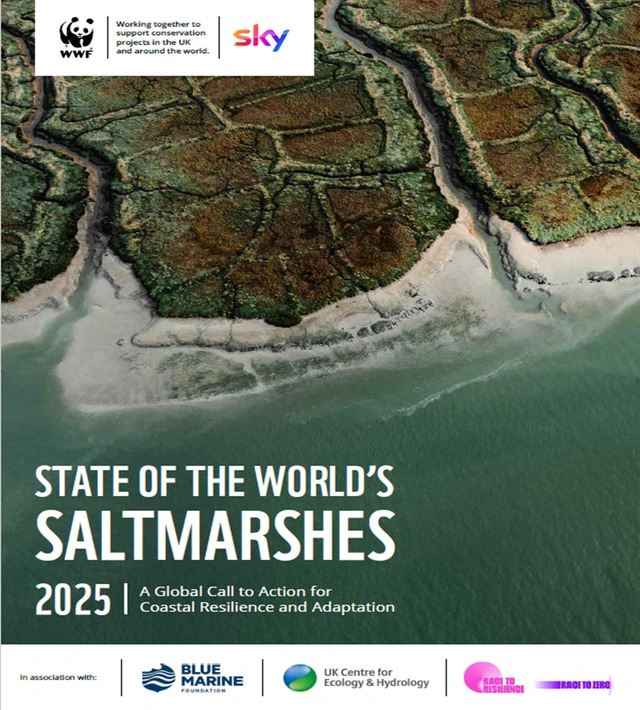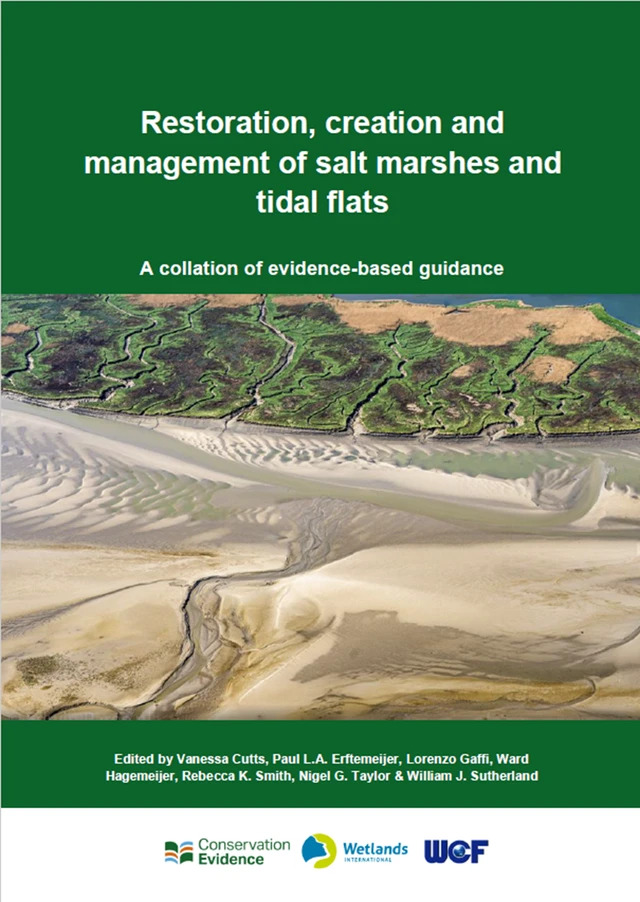
The Silent Frontline: The Status of the World’s Saltmarshes
In early mid-2025, WWF – UK partnered with Sky, in collaboration with the Blue Marine Foundation, the UK Centre for Ecology & Hydrology, and the UN Climate Change High Level Champion launched a publication entitled “State of the World’s Saltmarshes” https://www.wetlands.org/state-of-the-worlds-saltmarshes/. Our organisation, Wetlands International, in collaboration with the Conservation Evidence Group at the University of Cambridge, contributed to the drafting of Section 4: Scaling Solution, which is generally draws heavily from our landmark publication entitled “Restoration, Creation and Management of Salt Marshes and Tidal Flats”. This section focuses on various practices that drive the restoration of saltmarsh globally.


The report is the most comprehensive global assessment on saltmarsh, and the findings presented in it not only reveal the alarming scale of the crisis, but also offer a roadmap for recovery. The report summarizes the work of nearly 100 researchers and practitioners from more than 30 countries, prompting us to reassess the way we treat coastal areas—and recognize that these muddy wetlands are an important ally in the face of the climate crisis.
At first glance, saltmarsh is often mixed with saltpan, which although both are types of coastal wetlands, they have different physical and ecological appearances and functions. Saltmarsh is a coastal wetland that is periodically inundated with seawater, dominated by salt-tolerant plants (halophytes), and serve as an important habitat for biodiversity, coastal protection and carbon sink (blue carbon). This type of wetland ecosystem is usually located along river mouths, lagoons or bays that are influenced by tides, spread across the east coast of Sumatra (South Sumatra, Riau), the coast of Kalimantan, part of the North Coast of Java. The Ramsar Convention (Convention on Wetlands) includes saltmarsh in the type of wetlands in the coastal category (Marine/Coastal Wetlands) with the initials category H (Intertidal Marshes) which includes Saltmarshes, salt meadows, and raised salt marshes.
Meanwhile, saltpan is a flat soil surface that is very salty and formed naturally or artificially, where the water is shallow and quickly evaporates, leaving a salt crust on the surface of the soil. Saltpan is almost not overgrown by vegetation because of its very high salt content, and is generally used as a pond for salt production purposes by the community or industry. In Indonesia, saltpan located in Madura Island, part of North Coast of Java and East Nusa Tenggara.
Saltmarsh looks like a flat expanse full of grass that is flooded with seawater regularly. But behind its simple form, this ecosystem is very productive and complex. This ecosystem is like a biological machine that provides life support for fish, crabs, waterfowl, and other coastal biodiversity food webs. Its soil is always wet and poor in oxygen makes the process of organic decomposition slow down drastically, so that carbon is locked up for centuries. Each hectare of carbon can even store up to five times more carbon than tropical forests, making it a key element of blue carbon for climate change mitigation. Recent research emphasizes the role of saltmarsh as natural carbon stores, but also notes that restored saltmarsh takes tens to hundreds of years to rival the carbon reserves of mature wetlands. Protecting intact habitats istherefore the fastest and most effective mitigation strategy. In their other functions, they have long been the silent guardians of our coastline. They dampened storm surges, protected land from erosion, supported fisheries, and locked carbon in their deep, rich mud. Its dense vegetation and sloping land are able to dampen wave energy and reduce the impact of flooding caused by storms. This service is increasingly important in the era of rising sea levels and extreme weather. Saltmarsh also acts as a natural defence for the sea, filters pollutants, improves water quality, and provides important habitat for fish and shrimp that sustain fisheries. For many coastal communities, these services are not only about ecology but also about economics and security.
However, behind that important role, the ecosystem is now disappearing at a pace that exceeds the world’s forest loss. Saltmarsh is now experiencing a serious decline in area. History shows that this ecosystem globally was once estimated to cover more than 130,000 km². Today, less than half remains—about 53,000 km², equivalent to a 67% decline since pre-industrial. In just the period from 2000 to 2019, the world lost 1,435 km² of saltmarsh—an area about twice the size of Singapore. This loss rate is about three times faster than global deforestation. The loss is estimated to have released 326 million tonnes of CO₂ equivalent into the atmosphere —nihilizing decades of benefits of natural carbon sequestration. The rate of loss is 0.28% per year, or three times faster than the loss of forest cover.
There are many factors driving this decline. Historically, salt marshes were drained and dammed for agriculture and urban development. Infrastructure such as ports, roads and embankments alter the flow of water and break up habitats. Aquaculture is also often replacing saltmarshy areas, while climate change is adding to the pressure: rising sea levels and stronger storms threaten to drown these habitats. Last but not least, invasive species such as Spartina alter habitat structure and sediment dynamics, so less careful restoration can worsen susceptibility.
Hope Through Restoration
Saltmarsh is often thought of as a useless swamp, but the report we are talking about confirms the opposite. They are important allies in the face of climate change, supporting biodiversity, and protecting coastal communities, including their livelihoods. Losing it is a global crisis with real costs—not just the environment but also social and economic. But this is a challenge that can be overcome. With strong scientific evidence, proven restoration techniques, and the right policy support, saltmarsh protection and restoration offer a rare opportunity to invest in natural resilience that benefits people and the planet.
“Losing the saltmarsh means losing the front line of our defence against the climate crisis. Protecting and restoring it is an option for a future where nature is a partner, not a victim.”
The “State of the World’s Saltmarshes” report not only lays out the problem, but also offers science-based solutions. The analysis shows that about 20,000 km²—the equivalent of 2 million hectares—of lost or degraded salt marshes can be restored worldwide. This effort has the potential to prevent or sequester 36 million tons of CO₂ per year. Successful projects in Europe, the United States, China, and Australia show that restoration can be successful if it is well planned and involves local communities. However, the report also reminds that restoration is not an instant solution. The newly restored saltmarsh takes decades to match the carbon storage capacity of mature wetlands. Restoration design must also consider local hydrology and sediment for sustainable outcomes.
To halt and reverse the decline of saltmarsh, this report recommends five key actions:
1. Integrating saltmarsh conservation into national climate and biodiversity plans;
2. Raising public and private funding for conservation and restoration;
3. Improve mapping and monitoring, especially in tropical and polar regions where data is lacking;
4. Align saltmarsh conservation with international targets such as 30×30 (protecting 30% of land and oceans by 2030);
5. Increase public awareness of the value and benefits of saltmarsh.
The Ramsar Convention supports and promotes saltmarsh as part of coastal wetlands of international importance. Ramsar Resolution XIII.20 (2018) even affirms the importance of “coastal blue carbon ecosystems” which include salt marshes, mangroves and seagrasses.
It can be concluded that protecting salt marshes will actually increase 1) ecosystem productivity because it supports the nitrogen cycle, serves as a breeding ground for fish and invertebrates and supports biodiversity corridors, 2) coastal resilience by dampening wave energy and resisting storm strength, reducing the risk of flooding for vulnerable coastal communities, 3) time challenges, even restored swamps take a very long time to be able to accumulating soil carbon, so that maintaining and protecting existing swamps today will provide immediate climate benefits, and 4) carbon sequestration efficiency, where saltmarsh lock organic carbon deep in anaerobic, low-oxygen sediments, thereby slowing decomposition and creating long-term storage.
Although this report is global in its coverage, for the Indonesian context, an overview of existing conditions, benefits, threats and recommended action strategies can also be applied nationally. The most important challenge in Indonesia is to obtain data on the inventory of the distribution of the ecosystem, the problems and the area that can be restored, so that a more organized and measurable national strategy can be formulated.
By :

